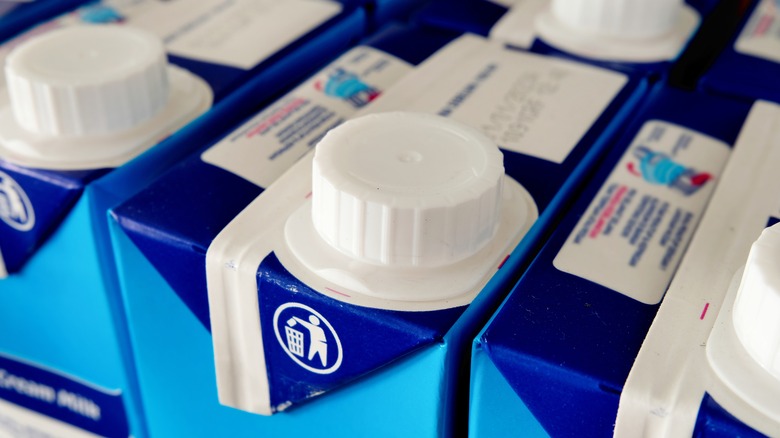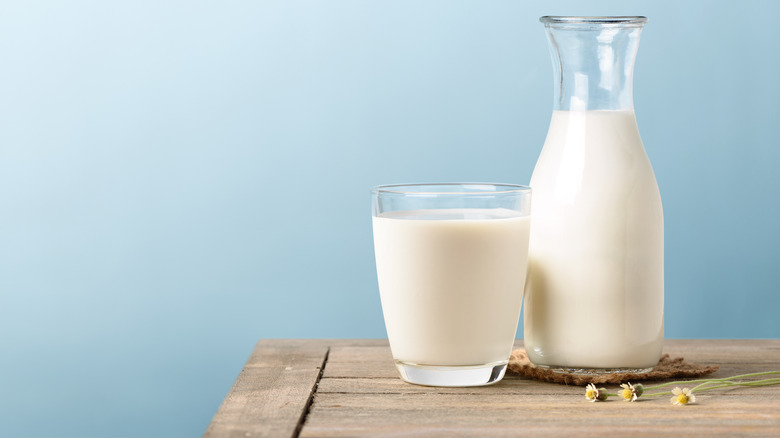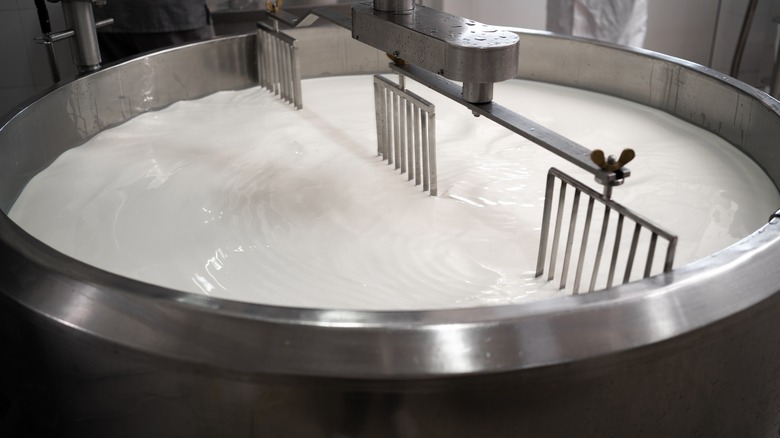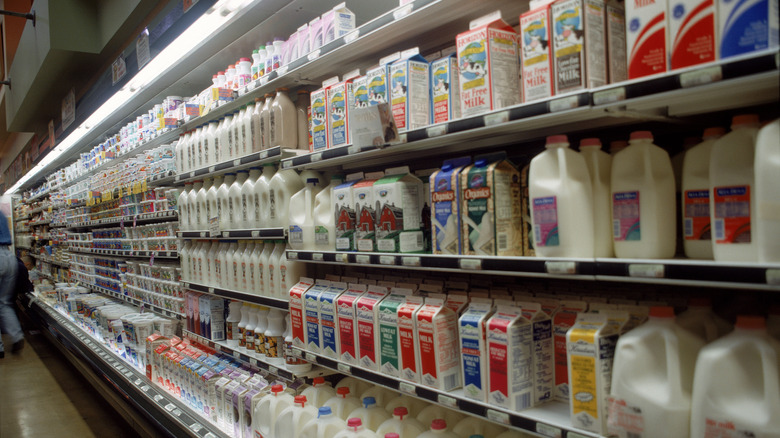Toned Milk: What Is It And How Is It Produced?
Across cultures and generations, humans have loved milk not just as a beverage but also as a crucial part of cultural cuisines. Packed with essential nutrients like calcium, potassium, magnesium, and vitamins A and B, it's nature's perfect gift to us. But it's not just the nutrients that keep us chugging milk; it tastes delicious as well. Plus, it's so versatile that it can be transformed into yogurt, ice cream, smoothies, cheese, and much more. There a numerous types of milk available too, from the ever-popular cow's milk to lesser-known types, such as toned milk.
According to the U.S. Department of Agriculture (USDA), kids should drink about 2 cups of milk daily, while teens should aim for three. Many adults, too, would love to make milk a part of their daily diet, but for one problem: all the fat it contains.
Enter toned milk: a uniquely tailored dairy product from India offering the richness of full-fat milk minus the unwanted fats. It has none of the features you dislike about low-fat milk, such as the watery texture and bland taste. But it retains beloved milk benefits, such as rich nutrients and delicious flavor. If you're unfamiliar with toned milk, you're in for a treat. Join us on the journey to understand what's so special about this product and its possible benefits.
What is toned milk?
Toned milk is essentially a type of low-fat milk made from buffalo milk. But it's not just any kind; it's designed to have a better nutrient profile than you'd expect from dairy products with reduced lipid content. Therefore, while the fat has been cut to about 3%, it still gives you the same healthy value.
One way to describe toned milk is as watered-down buffalo milk. This is because its main ingredients are whole buffalo milk blended with skim milk. Some brands may choose to use full-fat cow milk instead, but the end product remains consistent.
Although toned milk was developed more than 70 years ago in India, it's still a huge deal today. For Indian shoppers, this dairy product makes getting milk's nutritional goodness more affordable. Countless cartons of toned milk fill the stores in India, so it's accessible to just about anyone. Despite the benefits attributed to consuming toned milk, this refreshing beverage hasn't quite gained popularity globally.
How Is toned milk made?
Indian Businessman and milk commissioner D. N. Khurody created toned milk in 1946. There was nothing like this in the market then, so it was an immediate hit when he launched it in Bombay. Soon enough, this innovative dairy blend spread to nearby cities, eventually winning the hearts of the entire nation. The recipe for making toned milk is quite simple. It begins with gathering your two most vital ingredients: skim milk, which could be powdered, and fresh buffalo milk. You also need the right equipment, especially a milk pasteurization tank with an agitator.
The next step involves heating water to the right temperature, typically around 38 – 40 degrees Celsius. Stir this in the tank as you add powdered skim milk, ensuring you get an even mixture without lumps. Now, it's time to pour in the fresh buffalo milk. The required amount is carefully calculated and blended into the mixture till smooth.
The resulting milk blend is further processed by filtration and pasteurization at 63 degrees Celsius for 30 minutes. This kills any nasty bugs in the mixture that could cause diseases, making it safe for drinking and longer lasting. Finally, the toned milk is cooled to about five degrees Celsius, packed in containers, and stored at this temperature till distribution.
Toned milk Vs whole milk
When comparing whole and toned milk side by side, the most significant difference is in how much fat they contain. On average, toned milk is a slightly lower fat option. Another critical difference is the amount of calories you get in each serving. Toned milk is made using dairy from two animal sources, buffalo and cow. Conversely, regular whole milk is typically obtained from just one animal source, usually cows.
Furthermore, these dairy products differ in market distribution. Regular whole milk is found worldwide in almost any store you enter. Plus, with so many brands and flavors, you can always find something that suits your tastes and dietary requirements. Unfortunately, toned milk is not as easily accessible if you live outside India.
Despite all these differences, toned and whole milk are nearly identical regarding other nutrients. Both provide roughly the same amount of protein and calcium. Plus, you still receive the nourishment of the numerous micronutrients that dairy provides.
What does toned milk taste like?
Generally, milk tastes creamier and richer with higher fat content. Besides the inferior flavor of low-fat dairy, some, like skim milk, aren't necessarily healthier, so you understand why many people aren't huge fans. But toned milk is an entirely different ball game. It offers consumers the perfect way to crack down on fat intake without compromising taste. Unlike skim milk's disappointing chalky taste and watery texture, toned milk is pleasantly creamy with a rich flavor. If you're wondering how toned milk tastes so good? The secret is in the fresh milk added, especially the buffalo milk.
You see, buffalo milk is naturally sweeter and thicker than good old-fashioned cow milk. So, although this modified dairy drink has been diluted to make it less fatty, it's not enough to dampen the taste. To be fair, while toned milk tastes a lot better than other low-fat options, it's still not the same as full-cream milk. Even though it comes close in taste and texture, you'll still notice that toned milk has a weaker flavor.
How to use toned milk
While toned milk is great in cereal, tea, and coffee, it could also be just as helpful in the kitchen. In fact, it can work in almost any milk recipe, including baking, sauces, smoothies, ice cream, and even gravy. Surprisingly, traditional Indian dishes like rice porridge, kheer, turn out thick and delicious when made with toned milk.
Essentially, if the cooking recipe doesn't specify what kind of milk you should use, opting for toned or double-toned milk is a versatile choice. Keep in mind that cooking with toned milk may sometimes require extra effort or steps. For example, when making creamy curd, dahi, with toned milk, ensuring you start at the right temperature and whisk thoroughly are crucial if you don't want a watery mess.
Any dish you make with toned milk instead of regular whole milk automatically becomes low in fat. But the reality is that it might not turn out exactly the same. While it won't taste bad, it just might not have the same luxurious taste and texture as full-fat milk.
Where to buy toned milk
Where you can buy toned milk depends on where you reside. If you live in India and neighboring countries where toned milk is incredibly popular, you'll have no problem getting a bottle. This is because you can easily walk into any grocery store and grab one. Unfortunately, people residing in countries where toned milk hasn't entirely caught on yet have limited options. The reality is that most general stores don't carry this product, so check out specialized Indian stores instead.
Alternatively, consider shopping for toned milk online, but even then, you're limited to only a few stores. Start your search on Amazon, where you'll find a handful of toned milk brands that can be shipped to your location. Nava Fresh is another excellent online store that carries toned milk. This way, you can enjoy the fantastic benefits of this product despite the distance.
However, there are a few challenges with buying toned milk online. First, some stores only carry one brand, so you may not find a specific type or variety you like. Another major challenge is that this product costs way more than your average gallon of milk.
Nutritional information about toned milk
The standard for toned milk is only 3% total fat and 8.5% non-fat solids. However, this varies slightly among different brands. Healthline says low-fat dairy products like this are excellent for your body as they help maintain healthier cholesterol levels.
One hundred milliliters of toned milk contains only about 58.2 to 60 calories. That's only 6% of your daily energy requirement. Despite being low in calories and fat, it nourishes you with approximately 3 to 3.3 grams of protein. This is almost the same as whole milk, which gives you 3.15 grams of protein.
But wait – there's more. Getting calcium for strong bones and teeth is one reason we love milk; thankfully, toned milk provides just enough. In a 100-milliliter serving, you may get 110 to 124 milligrams of calcium. Once again, this is around the same range as whole milk. Toned milk is also a rich source of vitamin A and other micronutrients your body needs.
Varieties of toned milk
For shoppers who would prefer even less fat than contained in toned milk, there's another option on the menu: double-toned milk. As you can probably tell by the name, this unique blend comes from the additional processing of toned milk. These extra steps strip nearly half of the milk's usual lipid content, leaving you with dairy that has only about 1.5% total fat.
With such a significantly reduced lipid content, double-toned milk has become the top choice for some, especially those trying to lose weight. This milk variety is believed to help protect the heart. Another perk to drinking double-toned milk is that it's easy on the gut. In addition, 100-milliliter servings provide consumers with up to 3.2 grams of proteins and only 47.5 calories. Essential nutrients like calcium aren't lacking either. Stores also offer toned and double-toned milk in exciting flavors like vanilla and strawberry so that you can indulge in a wide range of options.
How to store toned milk
Toned milk is typically processed in such a way that it's shelf stable. This means that, unlike regular milk that must be kept in the fridge, this product can usually sit in your pantry for as long as it remains unopened. Some brands are still good to drink even up to 180 days post-production if you store the bottles in a cool, dry place.
On the flip side, once you open the pack of toned milk, the storage requirements change. You can't keep the leftover milk on your shelf, as it must be kept safely in your refrigerator. Even then, opened bottles of toned milk can only be stored for two days, after which it becomes unsafe to consume. Freezing this milk isn't an option either, as it will alter the distribution of the constituents and change the texture. Warning: if your pack of toned milk appears swollen or leaks, you shouldn't drink it. This could be a sign that the protective cover has broken and the milk is going bad.









